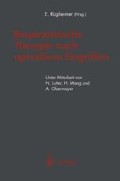Zusammenfassung
Verglichen mit den Adaptationsvorgängen an Hypoxie, die auf biochemischem und molekularem Gebiet in der Humanphysiologie und klinischen Bioenergetik bekannt sind, weisen die Anpassungen an O2-Mangel im gesamten Tierreich eine erstaunliche Komplexität und Flexibilität metabolischer Stoffwechselprozesse auf (Gnaiger 1993a). Ökologisch ist die Hypoxie besonders in aquatischen Lebensräumen ausgeprägt, was auf die 30- bis 50fach geringere Sättigungskonzentration von Sauerstoff in Wasser im Vergleich mit Luft zurückzuführen ist. Doch auch die Zellen des menschlichen Organismus befinden sich in einem wässrigen Mikromilieu, in dem bei Drosselung der O2-Zufuhr ein schnelles Abfallen des intrazellulären pO2 die Folge ist.
Unterstützung durch den Fonds zur Förderung der wissenschaftlichen Forschung, P7162-BIO, und ein Projekt des BMWF, Österreich. Ich bedanke mich bei Herrn Univ.-Prof. Dr. Raimund Margreiter für sein Interesse und seine Unterstützung.
Access this chapter
Tax calculation will be finalised at checkout
Purchases are for personal use only
Preview
Unable to display preview. Download preview PDF.
Literatur
Buck LT, Hochachka PW, Schön A, Gnaiger E (1993) Microcalorimetric measurement of reversible metabolic suppression induced by anoxia in isolated hepatocytes. Am J Physiol 265: R1014 - R1019
Cerretelli P (1993) Aerobic and anaerobic metabolism in hypoxia in vertebrates. Verh Dtsch Zool Ges 86: 177–202
Crow MT, Kushmerick MJ (1982) Chemical energetics of slow-and fast-twitch muscles of the mouse. J Gen Physiol 79: 147–166
Driedzic WR, Gesser H (1994) Energy metabolism and contractility in ectothermic vertebrate hearts: hypoxia, acidosis, and low temperature. Physiol Rev 74: 221–258
Ferguson RA, Boutilier RG (1989) Metabolic-membrane coupling in red blood cells of trout: the effects of anoxia and adrenergic stimulation. J Exp Biol 143: 149–164
Gnaiger E (1977) Thermodynamic considerations of invertebrate anoxibiosis. In: Lamprecht I, Schaarschmidt B (eds) Applications of calorimetry in life sciences. De Gruyter, Berlin, pp 281–303
Gnaiger E (1980) Energetics of invertebrate anoxibiosis: direct calorimetry in aquatic oligochaetes. FEBS Lett 112: 239–242
Gnaiger E (1983) Heat dissipation and energetic efficiency in animal anoxibiosis. Economy contra power. J Exp Zool 228: 471–490
Gnaiger E (1991) Animal energetics at very low oxygen: information from calorimetry and respirometry. In: Woakes R, Grieshaber M, Bridges CR (eds) Strategies for gas exchange and metabolism. Cambridge Univ Press, London (Soc Exp Biol Sem Ser 44: 149–171)
Gnaiger E (1993a) Efficiency and power strategies under hypoxia. Is low efficiency at high glycolytic ATP production a paradox? In: Hochachka PW, Lutz PL, Sick T, Rosenthal M, Van den Thillart G (eds) Surviving hypoxia: mechanisms of control and adaptation. CRC, Boca Raton Ann Arbor London Tokyo, pp 77–109
Gnaiger E (1993b) Homeostatic and microxic regulation of respiration in transitions to anaerobic metabolism. In: Bicudo JEPW (ed) The vertebrate gas transport cascade: adaptations to environment and mode of life. CRC, Boca Raton Ann Arbor London Tokyo, pp 358–370
Gnaiger E (1993c) Nonequilibrium thermodynamics of energy transformations. Pure Appl Chem 65: 1983–2002
Gnaiger E, Kemp RB (1990) Anaerobic metabolism in aerobic mammalian cells. Information from the ratio of calorimetric heat flux and respirometric oxygen flux. Biochim Biophys Acta 1016: 328–332
Hand SC (1993) pHi and anabolic arrest during anoxia in Artemia franciscana embryos. In: Hochachka PW, Lutz PL, Sick T, Rosenthal M, Van den Thillart G (eds) Surviving hypoxia: mechanisms of control and adaptation. CRC, Boca Raton Ann Arbor London Tokyo, pp 171–185
Hand SC, Gnaiger E (1988) Anaerobic dormancy quantified in Artemia embryos: a calorimetric test of the control mechanism. Science 239: 1425–1427
Heldmaier G (1993) Seasonal acclimatization of small mammals. Verh Dtsch Zool Ges 86: 67–77
Hochachka PW (1986) Defense strategies against hypoxia and hypothermia. Science 231: 234–241.
Hochachka PW, Somero GN (1984) Biochemical adaptation. Princeton University Press, Princeton NJ
Hontoria F, Crowe JH, Crowe LM, Amat F (1993) Metabolic heat production by Anemia embryos under anoxic conditions. J Exp Biol 178: 149–159
Land SC, Hochachka PW (1994) Protein turnover during metabolic arrest in turtle hepatocytes: role and energy dependence of proteilysis. Am J Physiol 266: C1028–C1036
Malan A (1993) pH and metabolic depression in mammalian hibernation. The example of brown adipose tissue. In: Hochachka PW, Lutz PL, Sick T, Rosenthal M, Van den Thillart G (eds) Surviving hypoxia: mechanisms of control and adaptation. CRC, Boca Raton Ann Arbor London Tokyo, pp 201–214
Prigogine I (1980) From being to becoming. Time and complexity in the physical sciences. Freeman, New York
Rosenthal M, Lamanna JC, Joebsis FF, Levasseur JE, Kontos HA, Patterson JL (1976) Effects of respiratory gases on cytochonrome a in intact cerebral cortex: Is there a critical po,? Brain Res 108: 143–154
Suurkuusk J, Wadsö I (1982) A multiple channel modular microcalorimeter. Chim Scripta 20: 155–163
Wiesner RJ, Kreutzer U, Rösen P, Grieshaber MK (1988) Subcellular distribution of malateaspartate cycle intermediates during normoxia and anoxia in the heart. Biochim Biophys Acta 936: 114–123
Editor information
Editors and Affiliations
Rights and permissions
Copyright information
© 1995 Springer-Verlag Berlin Heidelberg
About this paper
Cite this paper
Gnaiger, E. (1995). Zelluläre und mitochondriale Adaptationsvorgänge bei Hypoxie. In: Rügheimer, E. (eds) Respiratorische Therapie nach operativen Eingriffen. Springer, Berlin, Heidelberg. https://doi.org/10.1007/978-3-642-78399-9_1
Download citation
DOI: https://doi.org/10.1007/978-3-642-78399-9_1
Publisher Name: Springer, Berlin, Heidelberg
Print ISBN: 978-3-540-57047-9
Online ISBN: 978-3-642-78399-9
eBook Packages: Springer Book Archive

